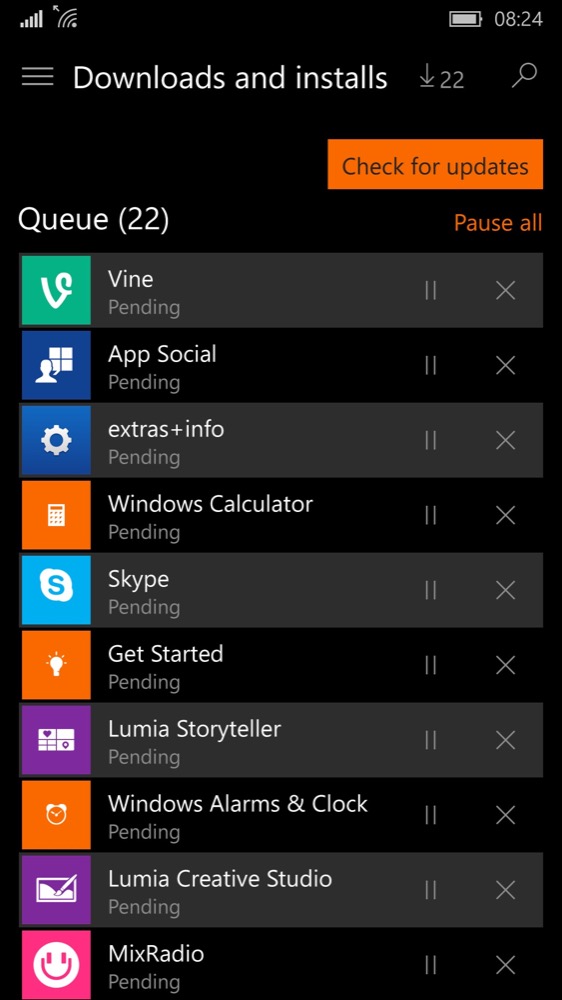NB. This procedure doesn't necessarily apply to anyone going back from an Insiders build to 'production' status, i.e. using the (Win32) Device Recovery Tool (DRT). You can grab this for yourself here if you don't already have it on your Windows 7, 8 or 10 system. The problem is that the backups made using a modern (Redstone/Redstone 2) Insiders builds aren't fully compatible with the production firmware images on Microsoft's servers, from the 'Threshold' days.
If you do go back to full production status - at least, at the time of writing, in early March 2017 - and you do try restoring immediately rom a modern backup then you'll end up with a phone with no Start screen! It's a known issue and just one of the gotchas of being on the Insiders programme and wanting to hop backwards and forwards. There's a workaround, of course, and I step through it here. (Quick preview: opt out of the Insiders rings, use the DRT to go back to 'production' Threshold, don't restore a backup, head straight for the production Anniversary Update, then hard reset once that's in place and only then opt to restore your original backup!)
So - you have a Windows 10 Mobile phone and it's got messed up with your own fiddling, with app installs, with previous Insider builds - whatever, you feel that a refresh is in order under the hood - here are the steps needed.
1. Export your podcast feeds
Go into your chosen podcatcher and clear its storage/cache of MP3s (since you don't want these to be needlessly backed up - they can always be downloaded again afterwards if needed). Now the important bit - make sure that feeds and/or database are backed up - this usually happens to OneDrive, but you may have to upload a file or two manually (e.g. in the ubiquitous OPML format) - depends on the app (Grover Pro is shown below).

2. Back up
Check you do have a full backup: go into Settings/Update & Security/Backup, and make sure both check boxes are on ('Back up content', 'back up settings'). Now tap on 'More options' and wait a few seconds while the information is retrieved from OneDrive. Check that 'Last backup' time and date is recent (e.g. within last 24 hours).
Also, check that backup is toggled on for all installed applications (see screenshot below) and perhaps consider doing an extra 'Back up now' (and then wait!!!)

3. Finish your games
You'll lose game states in most cases, so finish off that tricky title and draw a line under it before moving on?
4. Check you know your passwords
The usual precautions about double-checking that you have any relevant passwords (e.g. Microsoft, Google, Dropbox) to hand, to save messing around with recovery emails later!
5. Save your Start screen layout
A bit of a 'belt and braces' hack, this, but just in case the auto-restore of this doesn't happen(!), screenshot your current preferred Start screen layout (power+volume-up button), repeat for each screen's worth! Upload the resulting images to OneDrive or share them with yourself via email etc.
6. Photos, PIM up to date?
Make sure that all of your latest photos are synced up to Microsoft Photos by going into this and hitting the 'refresh' control. You don't want to risk losing a valuable recent photo!

Ditto for Outlook Mail and Calendar, do a final sync to make sure any latest phone tweaks to PIM apps are synced up to the cloud.
7. Take out your SIM if you're expecting a call
Take out SIM card and put in something else for the time being, if you're worried about not being phone-able for a few hours! You will need this downtime, not least for the large download in step 8a below!
8. Reset time
Head into Settings/System/About and scroll down to the 'Reset your phone' button. Tap this and confirm, to set the phone erasing itself - this will take several minutes, so be patient.

9. Signing in
You'll be faced with a smartphone that's showing the typical set-up screens: choosing country; accepting Microsoft's EULA; setting the date and time; selecting a Wi-fi network; agreeing to go 'Express' with default settings. You'll be familiar with all of these and it's not rocket science to work through.
Next is being given the chance to 'Sign in' and you'll almost certainly want to do this. Give the phone your Microsoft account email and password and tap 'Next' to get the OS looking in your account's online (hidden) backup area. The right and most recent backup will hopefully be highlighted in blue, but do double-check it. You may also be asked to complete two step verification by one of your chosen backup methods (e.g. code sent by SMS to your nominated phone number).
10. Restoring your settings and data
You're now faced by a number of restoration steps. The first involves a progress bar and should take about ten minutes - you might also be asked to confirm your details again at around the 20% mark, depending on which OS version you're on.
Next, step through the agreements for OneDrive and Cortana. Windows 10 Mobile then helpfully gives some hints along the lines of being patient in terms of the app installs. Which proves to be apt advice - you may think you're nearly there but in fact you've still got at least an hour of background application installs to (lightly) supervise.
11. Re-installing and updating applications
Head into the Store and look on the menu for 'Downloads and Updates' - hit this and then scroll through the long list of updates waiting until you come to the Store itself. Tap on its download icon and update this first, for a smoother ride overall! The Store will update and terminate, so then you can launch it again and go into 'Downloads and Updates' again - this time tap on 'Check for updates' if need be, and you should see around 40 or more updates waiting.

At this point it's safe to simply tap on 'Update all' and then go off and do something else for an hour or so. True you could insert your SIM at this point and use the phone for the basics, but I'd advise against it - your phone needs to be on Wi-fi and relatively undisturbed - it's doing a lot of installation work and will be slow and (probably) hot during this phase. So best leave it alone to get on with it.
12. Final checks
Once everything's installed and settled down, power down and insert your main SIM, then run through the basic applications to make sure that your PIM data syncs all happened OK. So that's Outlook Mail and Calendar - is everything restored/synced and in place? Use the 'Refresh' tool in each if not. And you'll want to head into your podcatcher too, importing all your shows/feeds from wherever you saved your exported list above.
Phew!
Don't be too disheartened by how many steps I've broken all this down with - although the various steps take quite a bit of real time while data shuttles backwards and forwards, there's not much for you to do and there's nothing too tricky.
Comments welcome if you feel the need to try all this - how much slicker does Windows 10 Mobile seem now? How much of a difference did the refresh make?
